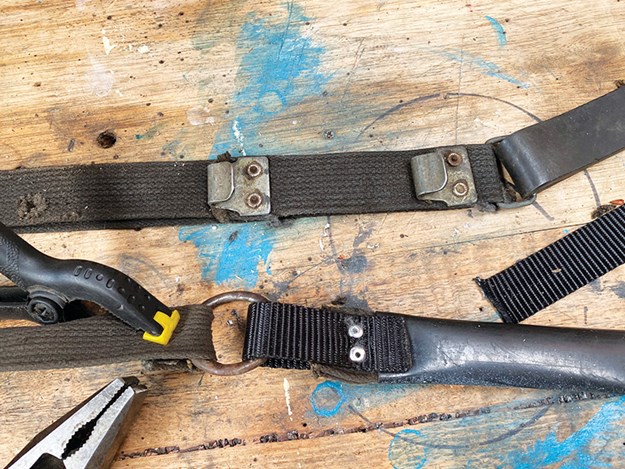Riveting stuff - Faine 463



|
In 1955 it was an astonishing contrast to anything else on the market
I bought my 1970 DS21 Citroen from Adelaide sight unseen, as I was prevented by the strict interstate travel Covid rules from making a quick South Australian inspection visit. After an independent expert pre-purchase inspection, I took a punt and purchased it anyway, and have no regrets. I have gambled buying cars without seeing them several times, and only once has it backfired and even then, the problems revealed were not disastrous – just annoying.
The futuristic DS was revealed to a disbelieving world in 1955. Fifteen years later, when my DS21 was made, the basic design was unchanged although some of the trimmings had evolved, as it continued to do until the longevity of the model caught up and it finished production in 1975. Throughout the 20-year production run, the DS featured the same front wheel drive and four-cylinder motor and the novelty of the suspension, brakes, steering and [in my version of the car] the clutch all powered by a belt driven hydraulic pump.
.jpg)
The Michelin cradle
The gearbox sits ahead of the motor, enabling the signature low profile snout often described as a shark nose. I think of it more as a beak, but whatever we call it, the aerodynamic advantage is obvious and in 1955 it was an astonishing contrast to anything else on the market. Even today it still looks ahead of its time. The absence of an upright traditional front grille meant airflow to the radiator has to be managed some other way, so there are ducts under the front bumper that direct air under the spare wheel, which sits tucked into a cradle behind the front bumper.
The spare is secured into its cradle with a cloth-weave strap, and inevitably over the decades of the car’s life, the wear and tear on this simple strap has taken its’ toll. On my car, it was rotten and broken, the fabric held together with ancient rusting staples and the spare wheel held in place by a series of temporary cable ties and work arounds which offended me every time I lifted the bonnet.
Replacement straps are available from European suppliers for about A$150 but as it is the first thing you see whenever the bonnet is lifted, I did not really want a brand new one. It would look a bit odd, as nothing else under the bonnet would be new and shiny. I like to try to keep things as original as possible, so I decided to replicate the broken bits and marry them to as much of the original as could be salvaged.

Faine cobbled new straps out of the old ones
The strap is in three sections, forming a ‘T’ with a large steel ring at the junction. I wanted to retain all the original metal hardware and fittings, just replacing the torn sections of woven cloth where needed. As I do not have an industrial sewing machine, and as the factory used pop rivets in the originals, I decided to add a few more and unite the old and the new in the same way - with small steel plates backing the rivets and holding my patches together.
A local saddlery supplier – Lefflers- had the closest I could find to original woven material and I dusted off the trusty hand riveter and my collection of pop rivets. Pieces cut to length were singed at each cut with a cigarette lighter to stop fraying, and then drilled for the rivets. Pre-drilling holes into the fabric proved tricky as the drill tended to tear the material instead of pierce it. Eventually after a few sacrificial attempts, I realised that the problem was as much where the material was drilled as how it was pierced. Any hole drilled near a loose end would fail, and the material was unravelling. But the drill would not foul if a hole was made away from an end, midway along, and then the material cut to size after. Keeping the strapping under tension also prevented the drill from tearing.
The small thin metal reinforcers were cut from a leftover scrap of a building truss, and then quickly and lazily shaped on the linishing belt. The riveter made quick work of the assembly, and my favourite new tool – a Knipex ratchet wrench – made retightening the clips back onto the spare wheel support panel a quick and easy finish.

I have replaced the front tyres with new and correct Michelin 180HR15 XAS tyres acquired at vast expense from Stuckeys, to replace the incorrect 185x15 Michelin knock-offs that were on the front wheels when I bought the DS. The spare was a balding and ancient Bridgestone, so one of the 185 Michelin replicas with plenty of tread became the spare. The slight difference between 180 and 185 tyre size stretches my refurbished spare tyre retainer strap, but the rubber belt takes the extra strain and now it all looks proper and sits rattle free and tight.
No animals were harmed in the making of this column, no tools were broken, no body parts injured. My wife says that I use too many pots and utensils when I cook and it feels the same in the shed. A small but satisfying afternoon’s work.
From Unique Cars #463, March 2022
Unique Cars magazine Value Guides
Sell your car for free right here
Get your monthly fix of news, reviews and stories on the greatest cars and minds in the automotive world.
Subscribe

.jpg)










.jpg)

